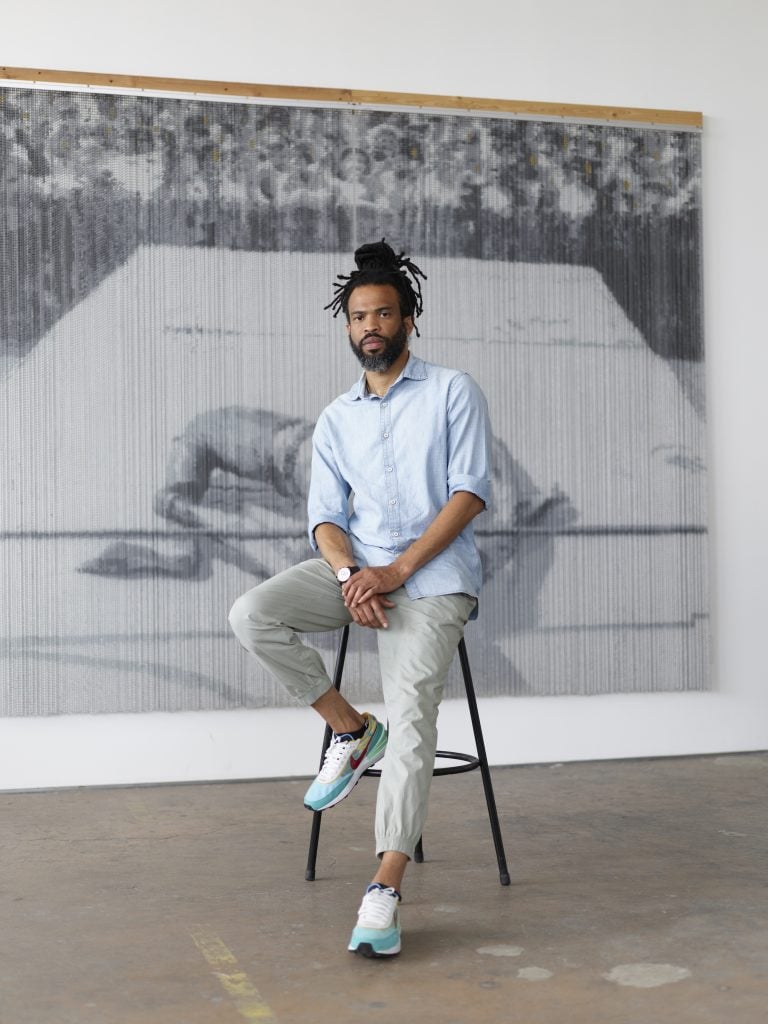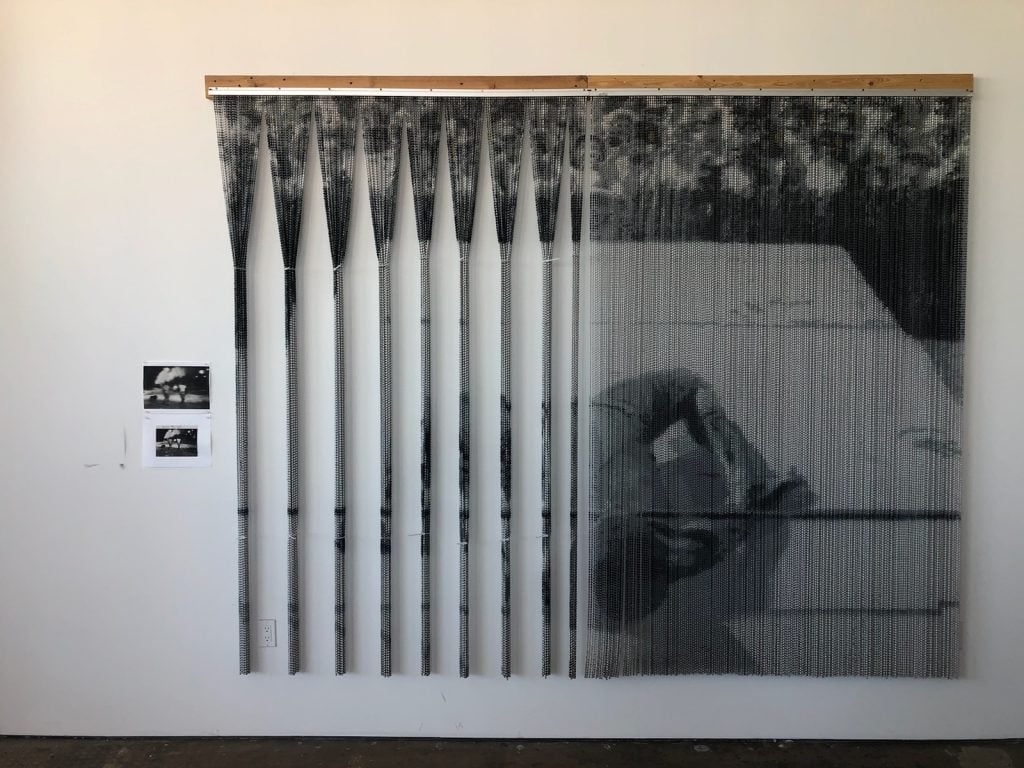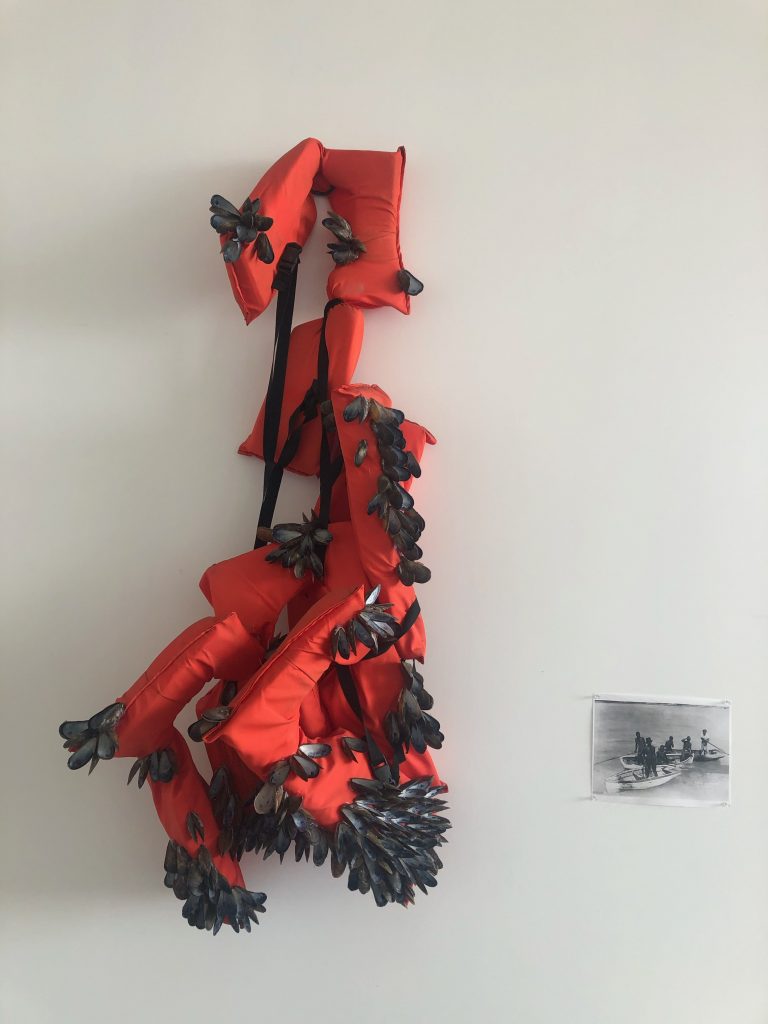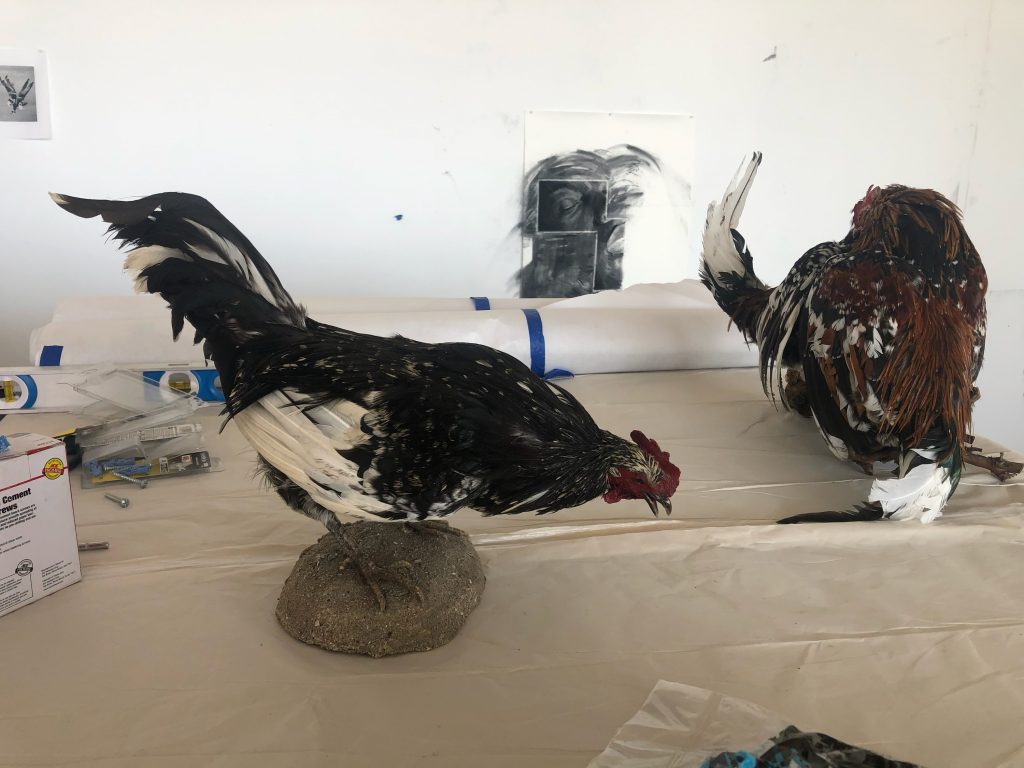Studio Visit
In His Downtown L.A. Studio, Artist Cosmo Whyte Works Nights Surrounded by Books, Beads, and Two Taxidermied Roosters
The artist's solo show "Hush Now, Don't Explain" is currently on view at Anat Ebgi in Los Angeles.

The artist's solo show "Hush Now, Don't Explain" is currently on view at Anat Ebgi in Los Angeles.

Katie White

Jamaican-born artist Cosmo Whyte (b. 1982) believes the past is a living, breathing being. The artist, who lives and works in Los Angeles, is known for his multidisciplinary works that explore how objects, documents, and even artworks can become emblems of time and its passage—and how these records are often wily in their truth-telling abilities.
Scouring archives of institutions large and small, Whyte seeks out captivating photographs, usually depicting African diasporic history, particularly that of the Caribbean. These photographs serve as the basis for his wide-ranging artistic interventions. “Hush Now, Don’t Explain,” the artist’s second solo exhibition at Anat Ebgi in Los Angeles, brings together his most recent explorations. Here, Whyte has rendered aspects of these archival photographs onto beaded curtains like those commonly found in his native Jamaica, allowing visitors to interact with these images while hinting at the porous nature of record-keeping. Similarly, in “Agitation,” a new series of large-scale drawings, Whyte introduces pixelation as a way of obscuring the identities of individuals in an image in order to refocus attention on the events themselves. These investigations of public and personal archives also take sculptural form; for the exhibition, Whyte has constructed a large metal structure based on drawings by his father, an architect, in the process asking complex questions about the space between artistic preservation and memorial.
Whyte develops his nuanced artworks in his studio in Downtown Los Angeles. The artist, who also teaches at UCLA, typically spends his nights in the studio—painting, drawing, and thinking.
Right before his show opened, we caught up with Whyte who told us what’s on his bookshelf, why he’s embraced the possibility of failure, and how “duds” sometimes come back to life.
Tell us about your studio. Where is it, how did you find it, what kind of space is it?
My studio is in the Fashion District in Downtown L.A. at Mohilef Studios. Stefano di Paola, a partner at Anat Ebgi, helped me find it. It’s an old garment warehouse with ample light and a great community of artists.
Do you have studio assistants or other team members working with you? What do they do?
I do, not full-time, but on a project basis. Aryana Polat is my current studio assistant. She is a very promising young artist. As a studio assistant, she’s been great. She’s helped troubleshoot ideas and is very organized and reliable. Also, since 2021 I have been working with Maggie Jones of FSU Master Craftsman on projects related to my series of beaded curtains. She has been instrumental in helping me streamline the painting process and logistics for those works.
How many hours do you typically spend in the studio, what time of day do you feel most productive, and what activities fill the majority of that time?
It depends on the time of year. While I’m teaching, I am in the studio in the evening and into the night, typically for three to five hours at a time. During the summer, or in periods when the teaching load is not as demanding, I’m there longer. In terms of what I do, I have periods of research where I am primarily reading, looking through archives, thinking through bodies of work, and sketching. There are periods when I need to step away from the studio to take in new stimuli and then there are other periods where I’m in full production mode. But I do believe the mind of an artist is always at work. You are always in the process of art-making and everything is a potential source of inspiration.

A work in progress in the artist’s studio. Courtesy of Cosmo Whyte.
What are you working on right now?
I’m working on a series of beaded curtains. They will be central to an installation for my solo exhibition. The curtains are all hand-painted and will be hung from an architectural structure in the middle of the gallery. The image depicted on the curtains is based on an archival image. The idea is that when you walk through the image, you momentarily disrupt the legibility of that image.
How do you know when an artwork you are working on is clicking? How do you know when an artwork you are working on is a dud?
I remember during my first year in grad school, I bought a roll of good paper. On a grad school budget, it was an expensive investment. To get over the preciousness of the paper, I decided to work on a large drawing until I broke it. There were several moments in the process where I knew if I just stopped here, I could salvage a good drawing or at least parts of it. I went into that exercise to embrace the process’s ups and downs and be completely open to the possibility of failure. I wanted to know: At what point does the artwork cross over and become overworked or unsalvageable, and what happens when you keep going?
That exercise was good because I was present through each stage of the process, paying close attention to my intuition. Now I immediately know when things are clicking and, more importantly, when to step back and regroup.
In terms of a dud, I have run into issues where I cannot fix a piece at a specific moment, but I don’t always discard the duds. I put them away and look at them later, maybe even a year later.

A work alongside an archival image. Courtesy of Cosmo Whyte.
When you feel stuck while preparing for a show, what do you do to get unstuck?
I have a very small circle of close friends I can talk to, to work through a project, writing, or idea. It’s reciprocal; whenever they’re bouncing around an idea, I try to make myself available to help. I trust them to be honest with me and value their opinion. Typically when I reach out, I am asking questions like: Does this make sense? Are these concepts getting across? How can I improve upon a particular piece? While their input goes a long way, ultimately, I must decide on what’s right for the work and my vision.
What images or objects do you look at while you work? Do you have any other artists’ work in your studio?
I have a bookshelf with artist monographs in the studio. I try to keep the majority of my books outside of the studio and only bring a handful into the workspace. Of late, I’ve been re-engaging with the paintings of Hurvin Anderson, Noah Davis, and Jennifer Packer. There is a quality to both Hurvin Anderson’s and Jennifer Packer’s paintings that feels so elusive and ephemeral. I really love their work.
As I continue to work on the curtains, my readings have become more focused on photography lately. The books currently in the studio are: The Civil Contract of Photography by Ariella Azoulay; Regarding the Pain of Others by Susan Sontag, which I am rereading; and I just picked up Seeing Through Race: A Reinterpretation of Civil Rights Photography by Martin Berger.
I also have a few archival images scattered around the studio. These are simple prints or photocopies. I like to keep them visible, as I may request to acquire rights to use them in a later project. Sometimes I’ll place them next to works I’ve made to see what kind of dialogue can happen. At the moment, I have one curtain piece of a limbo dancer next to an image of two women on a stroll in the aftermath of a protest in Florida in 1989. There is a tenderness as these two women hold hands amid the chaos that I just love. There is something interesting happening with it next to the contortion of the limbo dancer depicted in the curtain. I try to leave space for moments like this throughout the studio, to see what new direction the work can take.
What’s the last museum exhibition or gallery show you saw that really affected you and why?
A late professor of mine from Bennington College, Milford Graves, had a traveling retrospective at the ICA LA. Music was central to his work, but to see his sculptures was surprising and reminded me of my time with him in my last years as an undergraduate. He taught a class called Music Healing that looked at the role of sound in healing. He was an improvisational, experimental jazz drummer and the class had that improvisational structure. I still have notes from that course.
He was the only Black faculty during my time at Bennington and really took me on as an unofficial mentee my last year there. His support was very important and we kept in touch for a year after I graduated.
Seeing that show, I was still shocked at how good of a sculptor he was. I never knew that part of his practice. I knew him primarily as a musician, healer, and martial artist. It was beautiful to see his interest in Eastern medicine and experimental jazz and martial arts all coalesce in the show. It was very special and made me grateful for the time I had with him.

Two taxidermied roosters in the studio. Courtesy of Cosmo Whyte.
Is there anything in your studio that a visitor might find surprising?
I always have an odd collection of things in the studio, which I try to keep as organized as possible. I have a collection of airplane chairs which I have been making into sculptures since 2015. My latest surprising acquisitions are three taxidermied roosters that I ordered from eBay. Undoubtedly, they will become parts of some sculpture at some point. Right now, I need to sit with them. During my research, I found the majority of these taxidermied roosters come from Germany but the best taxidermied roosters are made in Ukraine. The standard of taxidermy there seems to be extremely high. Taxidermy roosters seem like an odd niche market.
How does your studio environment influence the way you work?
Over the years I have had so many different types of studios. As you would expect, size determines the possibilities of what you can do. I have tall ceilings, so this impacts my scale. Temperature is a factor, too. Sometimes it gets too hot, so I must adjust my work schedule. For instance, when working on the curtains, which are so labor intensive, I’d rather not be making those during the hottest time of the day. Going up and down scaffolding in the heat is taxing. So on those days, work begins in the early morning. However, when there is a looming deadline all that gets thrown out the window as the work must get done by any means. I also like my studio space. It’s a pleasure to come to it and work. It really makes a difference.